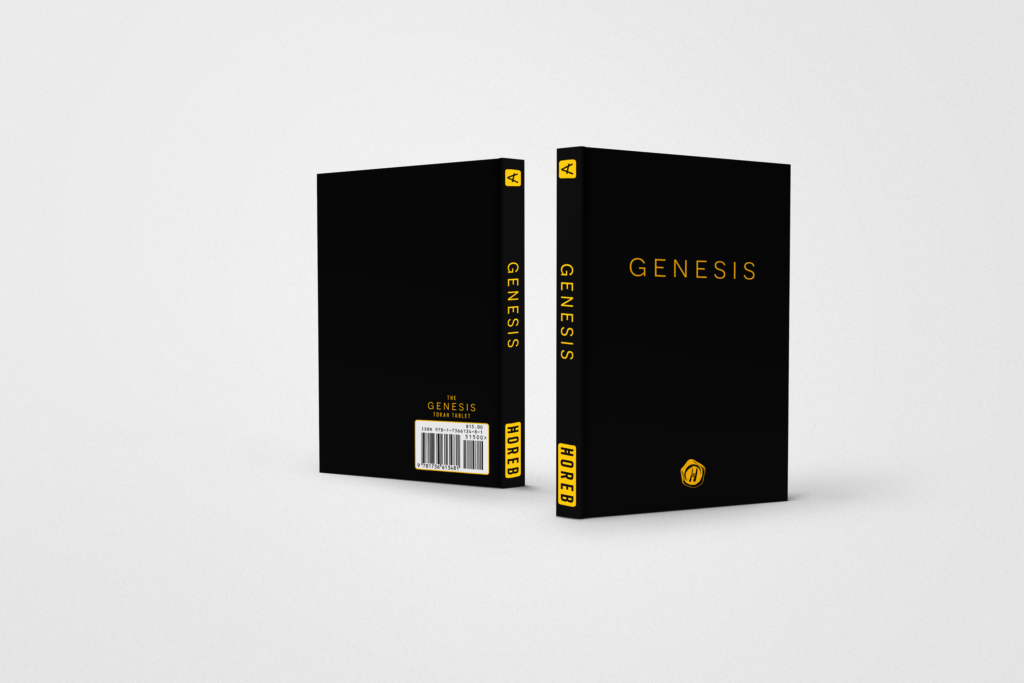As of this morning, we’re excited to share that The Genesis Torah Tablet is officially available for purchase on Amazon. This New Release inaugurates our Torah Tablets Series, embodying our dedication to fostering a profound and enriching interaction with the Pentateuch’s text.
This initiative, including the upcoming volumes of Exodus, Leviticus, Numbers, and Deuteronomy, is designed to offer a unique study experience. Tailored for enthusiasts of biblical studies with a special emphasis on a Hebraic perspective, the series merges traditional study methods with innovative approaches inspired by the popular trend of Scripture journaling, yet with a distinct Hebraic twist.
ORDER YOUR COPY TODAY at this LINK! As an Amazon Affiliate, I earn from qualifying purchases made through my link.

Key Highlights of The Genesis Torah Tablet:
Innovative Format Inspired by Scripture Journaling: Embracing the recent enthusiasm for Scripture journaling, our series introduces this accessible, reflective practice to the study of the Pentateuch, enhanced with unique elements rooted in Hebraic tradition and scholarship. Even numbered pages contain the Biblical text, and odd-numbered, facing pages are lightly ruled for note-taking.
Revitalized American Standard Version Text: The series features the American Standard Version (ASV) of 1901, chosen for its literal and faithful translation. We present this time-honored version with a new vitality, emphasizing the ancient textual divisions and reading cycles that bridge the historical with the contemporary.
Special Emphasis on Divine Names: Reflecting our commitment to depth and clarity, The Genesis Torah Tablet carefully highlights every occurrence of the Divine Name and titles. We acknowledge that there is no universally accepted agreement on the use or pronunciation of the Divine Name, represented by the Tetragrammaton, used thousands of times in the Hebrew Bible. Our choice to utilize the American Standard Version (ASV) of 1901 is intentional; unlike other translations that might sidestep the Tetragrammaton, the ASV makes a decisive choice by using “JEHOVAH.” This approach allows readers to engage with the Divine Name according to their own convictions when encountered in the text of our Torah Tablets. All divine titles are accentuated in bold and small caps to stand out for easy identification and contemplation, enhancing the reader’s engagement with these sacred texts.
Authentic Textual Layout with Respect to Ancient Traditions: A cornerstone feature of the Torah Tablets series is its faithful adherence to the authentic textual layout inspired by traditional Torah scrolls. Unlike most contemporary Bibles, which often introduce breaks based on later editorial decisions such as chapters (a late invention not reflective of the original manuscript structure) or formatting changes between prose and poetry, our series is committed to preserving the integrity of the ancient texts.
In the Torah Tablets, the textual divisions are meticulously based on the ancient breaks as indicated in the Leningrad Codex, the oldest complete copy of the Hebrew Bible. This means that the text flows as a continuous, justified block, interrupted only where authentic breaks exist in the ancient manuscripts. This approach allows the reader to engage with the scriptures in a format that is closer to their original context, free from the influence of later editorial choices. Our detailed attention to these ancient divisions exposes readers to a more authentic experience of the text, offering a unique window into the structure and rhythm of the sacred scriptures as they were traditionally read and understood.
By presenting the text according to these ancient guidelines, the Torah Tablets series invites readers to a deeper and more historically grounded interaction with the Word. This commitment to authenticity not only honors the tradition and sacredness of the scriptures but also enriches the reader’s study, offering insights into the text’s original compilation and design.
Comprehensive Integration of Ancient Torah Reading Cycles: A standout feature of our Torah Tablets series is the meticulous inclusion of both the Annual and Triennial Torah reading cycles, enriching the study experience with an unparalleled depth of tradition and scholarship. This dual approach offers a broad and in-depth exploration of the Pentateuch, catering to diverse study preferences and historical interests.
The Triennial Cycle, traced back to the late Second Temple period in the Land of Israel, represents a practice where the entirety of the Pentateuch was completed over a period of three to three and a half years. Despite slight variations in how these divisions are marked, our series faithfully uses the Leningrad Codex as the basis for indicating the precise triennial divisions. This ancient cycle allows readers to engage with the scriptures in a rhythm that closely mirrors the historical Jewish practice, providing insights into the spiritual and communal life of the Israelites.
Conversely, the Annual Cycle, developed in Babylon, presents a different tradition where the entire Pentateuch is read over the course of a single year. This cycle reflects the adaptation and evolution of Jewish scriptural engagement in the Diaspora, offering a comprehensive annual journey through these foundational texts.
By incorporating both cycles into the Torah Tablets series, we bridge the geographical and historical practices of Jewish scriptural reading from the ancient lands of Israel to the Babylonian exile. This comprehensive integration not only respects the rich diversity of Jewish tradition but also provides readers with a choice in how they wish to journey through the Pentateuch. Whether one is drawn to the detailed study afforded by the Triennial Cycle or the comprehensive overview of the Annual Cycle, the Torah Tablets series serves as an indispensable tool for a thorough and diverse exploration of these ancient texts.
This feature underscores our commitment to offering a study experience that is both authentic and adaptable to the varied interests of our readers. It highlights our dedication to preserving the historical and cultural integrity of the Pentateuch’s study practices while providing a flexible framework that accommodates individual study rhythms and preferences.
The inclusion of both the Annual and Triennial cycles not only pays homage to the Pentateuch’s rich tradition of oral and communal reading but also invites modern readers into a participatory experience of these ancient rituals. This dual approach allows for a personalized study experience, where one can either immerse in the text at the traditional pace of ancient Jewish communities or explore it through the more condensed annual cycle adopted later in Jewish history.
Our use of the Leningrad Codex for the triennial markings ensures that readers have access to the most historically accurate and authentic division of the text, offering a unique opportunity to connect with the scripture in a manner that is deeply rooted in tradition yet open to personal exploration and interpretation.
This meticulous attention to the integration of both reading cycles into the Torah Tablets series not only enriches the reader’s understanding of the Pentateuch but also deepens their appreciation for the diverse practices of Torah study that have sustained Jewish life and spirituality across millennia.
Inclusion of Documentary Hypothesis Insights: A significant aspect of our Torah Tablets series is the thoughtful inclusion of insights from the Documentary Hypothesis, a scholarly theory that suggests the Pentateuch is the result of a complex writing process involving multiple sources. This theory, which has been developed and debated by scholars since the late nineteenth century, proposes that the texts we now read as a unified whole originally stemmed from several distinct sources, traditionally labeled as J (Yahwist), E (Elohist), P (Priestly), D (Deuteronomic), R (Redactor), and occasionally O (Other).
Understanding that the Documentary Hypothesis represents a pivotal area of biblical scholarship, we have chosen to incorporate markings for these generally advanced divisions/sources within our series. Utilizing special fonts to denote passages makes it an indispensable resource for anyone seeking a deeper understanding of the Pentateuch. By navigating the complexities and depths of these ancient scriptures with an informed perspective, we invite readers into a more nuanced engagement with the text.
Our approach recognizes the value of scholarly debate and inquiry as a means to enrich one’s study and appreciation of the Bible. With the inclusion of the Documentary Hypothesis markings, the Torah Tablets series provides a distinctive opportunity for readers to explore the multifaceted nature of these foundational texts. Whether for academic study, personal reflection, or spiritual growth, the insights offered through this feature aim to deepen the reader’s connection to the sacred narratives, acknowledging the layers of tradition, history, and interpretation that they encompass.
As we continue to release the subsequent volumes of the Torah Tablets series, we remain committed to presenting a balanced and thoughtful exploration of the Pentateuch. The Genesis Torah Tablet sets the stage for this journey, offering a comprehensive and enriching exploration that honors tradition while embracing the insights and questions that modern scholarship brings to our understanding of these ancient texts.
I am grateful for the opportunity to share this work with you, crafted in collaboration with my son, Seth Nichols, and we look forward to the continued journey through the Torah Tablets series. Our hope is that these volumes will serve as valuable companions in your exploration of the Pentateuch, enhancing your study with insights that bridge the ancient and the contemporary, the scholarly and the spiritual.
Thank you for joining us on this journey of discovery and understanding. We are excited to delve deeper into the Pentateuch together, exploring its timeless wisdom and its relevance for today.



You are amazing, Ross! Cant wait to get my copy. Awesome stuff!